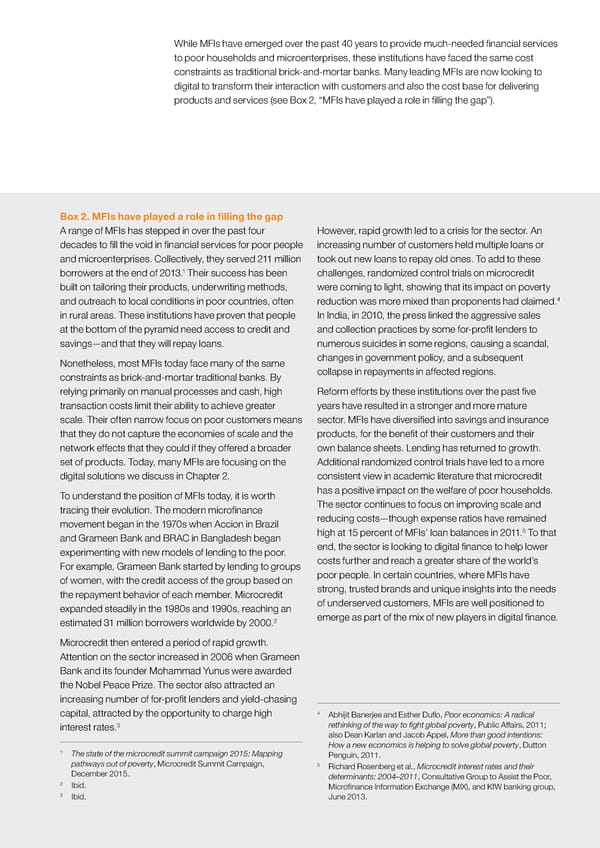While MFIs have emerged over the past 40 years to provide much-needed financial services to poor households and microenterprises, these institutions have faced the same cost constraints as traditional brick-and-mortar banks. Many leading MFIs are now looking to digital to transform their interaction with customers and also the cost base for delivering products and services (see Box 2, “MFIs have played a role in filling the gap”). Box 2. MFIs have played a role in filling the gap A range of MFIs has stepped in over the past four However, rapid growth led to a crisis for the sector. An decades to fill the void in financial services for poor people increasing number of customers held multiple loans or and microenterprises. Collectively, they served 211 million took out new loans to repay old ones. To add to these 1 borrowers at the end of 2013. Their success has been challenges, randomized control trials on microcredit built on tailoring their products, underwriting methods, were coming to light, showing that its impact on poverty 4 and outreach to local conditions in poor countries, often reduction was more mixed than proponents had claimed. in rural areas. These institutions have proven that people In India, in 2010, the press linked the aggressive sales at the bottom of the pyramid need access to credit and and collection practices by some for-profit lenders to savings—and that they will repay loans. numerous suicides in some regions, causing a scandal, Nonetheless, most MFIs today face many of the same changes in government policy, and a subsequent constraints as brick-and-mortar traditional banks. By collapse in repayments in affected regions. relying primarily on manual processes and cash, high Reform efforts by these institutions over the past five transaction costs limit their ability to achieve greater years have resulted in a stronger and more mature scale. Their often narrow focus on poor customers means sector. MFIs have diversified into savings and insurance that they do not capture the economies of scale and the products, for the benefit of their customers and their network effects that they could if they offered a broader own balance sheets. Lending has returned to growth. set of products. Today, many MFIs are focusing on the Additional randomized control trials have led to a more digital solutions we discuss in Chapter 2. consistent view in academic literature that microcredit To understand the position of MFIs today, it is worth has a positive impact on the welfare of poor households. tracing their evolution. The modern microfinance The sector continues to focus on improving scale and movement began in the 1970s when Accion in Brazil reducing costs—though expense ratios have remained 5 and Grameen Bank and BRAC in Bangladesh began high at 15 percent of MFIs’ loan balances in 2011. To that experimenting with new models of lending to the poor. end, the sector is looking to digital finance to help lower For example, Grameen Bank started by lending to groups costs further and reach a greater share of the world’s of women, with the credit access of the group based on poor people. In certain countries, where MFIs have the repayment behavior of each member. Microcredit strong, trusted brands and unique insights into the needs expanded steadily in the 1980s and 1990s, reaching an of underserved customers, MFIs are well positioned to 2 emerge as part of the mix of new players in digital finance. estimated 31 million borrowers worldwide by 2000. Microcredit then entered a period of rapid growth. Attention on the sector increased in 2006 when Grameen Bank and its founder Mohammad Yunus were awarded the Nobel Peace Prize. The sector also attracted an increasing number of for-profit lenders and yield-chasing capital, attracted by the opportunity to charge high 4 Abhijit Banerjee and Esther Duflo, Poor economics: A radical 3 rethinking of the way to fight global poverty, Public Affairs, 2011; interest rates. also Dean Karlan and Jacob Appel, More than good intentions: How a new economics is helping to solve global poverty, Dutton 1 The state of the microcredit summit campaign 2015: Mapping Penguin, 2011. pathways out of poverty, Microcredit Summit Campaign, 5 Richard Rosenberg et al., Microcredit interest rates and their December 2015. determinants: 2004–2011, Consultative Group to Assist the Poor, 2 Ibid. Microfinance Information Exchange (MIX), and KfW banking group, 3 Ibid. June 2013. McKinsey Global Institute Digital finance for all: Powering inclusive growth in emerging economies 25
 DIGITAL FINANCE FOR ALL Page 36 Page 38
DIGITAL FINANCE FOR ALL Page 36 Page 38